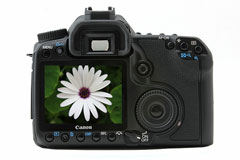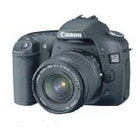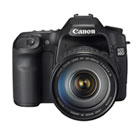The Canon 30D vs. the 40D
This page compares the features of the Canon 30D (release date: February 2006) vs the 40D (release date: September 2007).
While the 30D was quite similar to its predecessor (the 20D), the Canon 40D introduces more features and functionality.
The paragraphs that follow will help answer the questions:
- Will I leverage the extra features the 40D offers?
- Are those extra features worth the additional cost?
Key Differences
| Canon 30D | Canon 40D | |
| Megapixels | 8.0 | 10.1 |
| Continuous Speed | 5 photos/second | 6.5 photos/second |
| Image Buffer Size | 30 JPG or 11 RAW | 75 JPG or 17 RAW |
| LCD Size | 2.5 inch | 3.0 inch |
| Live View LCD | No | Yes |
| Dust Control | No | Yes |
| Wireless Transfer | No | Yes |
| Average Price | $800 | $1,150 |
That's the quick summary - let's dig into more details about each one of these 30D vs. 40D differences.
Megapixels
There really isn't a whopping difference between 8 and 10 megapixels. The 10 megapixel photos can just be printed at larger sizes.
The main reason the 40D features a 10 megapixel sensor is because 10 megapixel digital SLR are the norm these days.
Speed
The 40D features a pretty big jump in speed and performance over the 30D.
It has a continuous drive speed which is capable of capturing more photos per second, and it has a larger internal memory buffer, which can store more than double the number of images as the 30D before the camera slows down.
This brings us to an interesting question: how many people out there would blaze through 75 rapid-succession photos at 6.5 photos per second? What type of a subject would necessitate that type of photographic overkill?
The answer is that probably very few people (with the exception of those who wish to test the camera's performance) will ever max out the camera's capacity to take consecutive photos.
The real point here is that the Canon 40D will ALWAYS be ready to take the next shot, regardless of how many photos you've just taken.
You'll never have to wait for the camera to catch up (not that you really had to wait for the 30D either) which means that you'll be more able to capture a fleeting moment so long as you've got your finger poised on the shutter release.
Extra Features

There are three common features emerging on all digital SLR cameras - what I like to call the "digital SLR trifecta": dust control, image stabilization and a live view LCD.
The Canon 30D has none of these extra features - although with Canon cameras, image stabilization comes with the lenses not the camera - so you can get stabilization for the Canon 30D if you buy the right lens.
By comparison, the Canon 40D includes Canon's new dust control system (Canon EOS Integrated Cleaning System), and it has a live view LCD screen - a feature that was previously only available on the high-end (and extremely expensive) Canon EOS 1D Mark III.
The Live View LCD lets you compose photos without using the viewfinder - exactly the same thing you can do with any compact digital camera (whose viewfinders are significantly less useful).
The 40D also comes packaged with a new kit lens - the EF-S 18-55mm f/3.5-5.6 IS - with (guess what) image stabilization. With its built-in dust control and live view LCD and the addition of the image-stabilized lens, the 40D has managed to cover all three special digital SLR features.
Minor Features (Nice to Have's)
Now we're down to the little differences when comparing the Canon D30 vs. the D40.
The Canon D40 is compatible can "beam" files directly to a hard drive with the help of the WFT-E3A wireless transmitter. In this case, the number of photos you could take with the camera would only be limited by the size of the hard drive.
Another nice D40 feature is the ISO display in the viewfinder. The ability to change ISO on the fly is one of the most powerful features of any digital SLR camera.
The only problem is that high ISO settings add more noise (grain) to a digital photo. When the ISO isn't displayed in the viewfinder, it's pretty easy to forget that you've got it set to 1600 when you'd really like it to be set to 100 - which add a bunch of noise to photos that really shouldn't have it.
The last new feature of the D40 over the D30 is a new file format called sRAW.
Most digital SLR cameras have two main file formats: JPG and RAW. JPG images are compressed (losing some image detail) but you're able to save more of them on a standard size memory card. By contrast, RAW files are huge and require higher-capacity cards and more hard drive space.
The new sRAW format is a middle ground - all of the benefits of a RAW file (custom editing capacity and little loss of detail) but with reduced file sizes so that you can capture more of them on a standard memory card.
Related Links
| Digital SLR Home | Canon 40D Guide |





